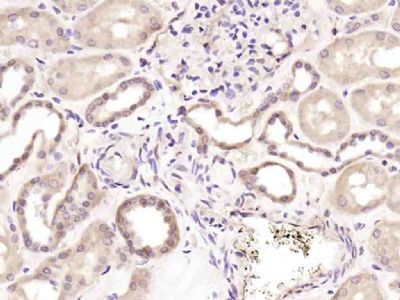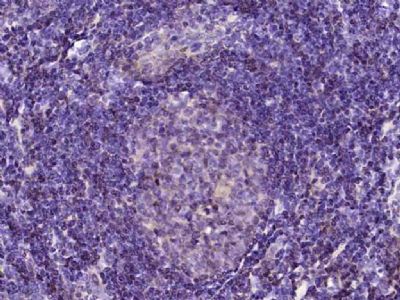DNA (cytosine-5-)-methyltransferase 1 has a role in the establishment and regulation of tissue-specific patterns of methylated cytosine residues. Aberrant methylation patterns are associated with certain human tumors and developmental abnormalities. Two transcript variants encoding different isoforms have been found for this gene. [provided by RefSeq, Aug 2008].
Function:
Methylates CpG residues. Preferentially methylates hemimethylated DNA. Associates with DNA replication sites in S phase maintaining the methylation pattern in the newly synthesized strand, that is essential for epigenetic inheritance. Associates with chromatin during G2 and M phases to maintain DNA methylation independently of replication. It is responsible for maintaining methylation patterns established in development. DNA methylation is coordinated with methylation of histones. Mediates transcriptional repression by direct binding to HDAC2. In association with DNMT3B and via the recruitment of CTCFL/BORIS, involved in activation of BAG1 gene expression by modulating dimethylation of promoter histone H3 at H3K4 and H3K9.
Subunit:
Binds to CSNK1D (By similarity). Homodimer. Interacts with HDAC1 and with PCNA. Forms a complex with DMAP1 and HDAC2, with direct interaction. Forms also a stable complex with E2F1, BB1 and HDAC1. Binds MBD2 and MBD3. Component of complexes containing SUV39H1. Interacts with DNMT3A and DNMT3B. Interacts with the PRC2/EED-EZH2 complex. Interacts with UBC9 and BAZ2A/TIP5.
Subcellular Location:
Nucleus.
Tissue Specificity:
Ubiquitous; highly expressed in fetal tissues, heart, kidney, placenta, peripheral blood mononuclear cells, and expressed at lower levels in spleen, lung, brain, small intestine, colon, liver, and skeletal muscle. Isoform 2 is less expressed than isoform 1.
Post-translational modifications:
Sumoylated; sumoylation increases activity.
Acetylation on multiple lysines, mainly by KAT2B/PCAF, regulates cell cycle G(2)/M transition. Deacetylation of Lys-1349 and Lys-1415 by SIRT1 increases methyltransferase activity.
Phosphorylation of Ser-154 by CDKs is important for enzymatic activity and protein stability. Phosphorylation of Ser-143 by AKT1 prevents methylation by SETD7 therebye increasing DNMT1 stability.
Methylation at Lys-142 by SETD7 promotes DNMT1 proteasomal degradation.
DISEASE:
Defects in DNMT1 are the cause of hereditary sensory neuropathy type 1E (HSN1E) [MIM:614116]. A neurodegenerative disorder characterized by adult onset of progressive peripheral sensory loss associated with progressive hearing impairment and early-onset dementia.
Similarity:
Belongs to the C5-methyltransferase family.
Contains 2 BAH domains.
Contains 1 CXXSLCtype zinc finger.
SWISS:
P26358
Gene ID:
1786
Database links:
Entrez Gene: 281119 Cow
Entrez Gene: 1786 Human
Entrez Gene: 13433 Mouse
Entrez Gene: 84350 Rat
Entrez Gene: 30430 Zebrafish
Omim: 126375 Human
SwissProt: Q24K09 Cow
SwissProt: P26358 Human
SwissProt: P13864 Mouse
SwissProt: Q9Z330 Rat
Unigene: 202672 Human
Unigene: 128580 Mouse
Unigene: 6955 Rat
DNA甲基转移酶-1在多种肿瘤细胞中表达量相当高,而在正常成人细胞中则低表达,因此dnmt1基因的高表达与肿瘤的发生有密切的关系。 dnmt-1 对细胞周期、增殖及凋亡有一定的的影响。细胞核表达。
(isoform CRA_a)为抑制细胞增殖、促进细胞凋亡,为肿瘤的基因治疗提供依据。
| Picture |
Paraformaldehyde-fixed, paraffin embedded (Human kidney); Antigen retrieval by boiling in sodium citrate buffer (pH6.0) for 15min; Block endogenous peroxidase by 3% hydrogen peroxide for 20 minutes; Blocking buffer (normal goat serum) at 37°C for 30min; Antibody incubation with (phospho-Dnmt1 (Ser154)) Polyclonal Antibody, Unconjugated (SL5294R) at 1:200 overnight at 4°C, followed by operating according to SP Kit(Rabbit) (sp-0023) instructionsand DAB staining.
Paraformaldehyde-fixed, paraffin embedded (human tonsil); Antigen retrieval by boiling in sodium citrate buffer (pH6.0) for 15min; Block endogenous peroxidase by 3% hydrogen peroxide for 20 minutes; Blocking buffer (normal goat serum) at 37°C for 30min; Antibody incubation with (phospho-Dnmt1 (Ser154)) Polyclonal Antibody, Unconjugated (SL5294R) at 1:200 overnight at 4°C, followed by operating according to SP Kit(Rabbit) (sp-0023) instructionsand DAB staining.
Blank control (Black line):Molt4 (Black).
Primary Antibody (green line): Rabbit Anti-phospho-Dnmt1(Ser154) antibody (SL5294R)
Dilution: 1μg /10^6 cells;
Isotype Control Antibody (orange line): Rabbit IgG .
Secondary Antibody (white blue line): Goat anti-rabbit IgG-AF647
Dilution: 1μg /test.
Protocol
The cells were fixed with 4% PFA (10min at room temperature)and then permeabilized with 90% ice-cold methanol for 20 min at room temperature. The cells were then incubated in 5%BSA to block non-specific protein-protein interactions for 30 min at room temperature .Cells stained with Primary Antibody for 30 min at room temperature. The secondary antibody used for 40 min at room temperature. Acquisition of 20,000 events was performed.
|
|
|


